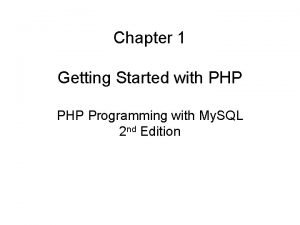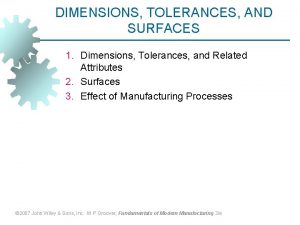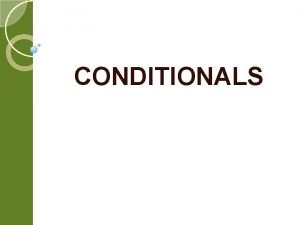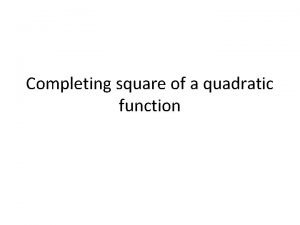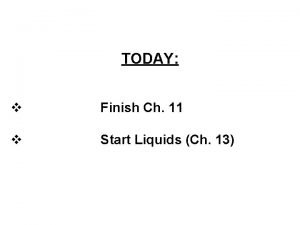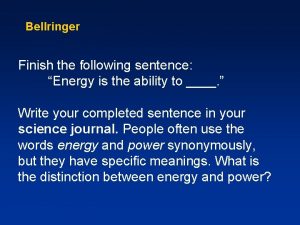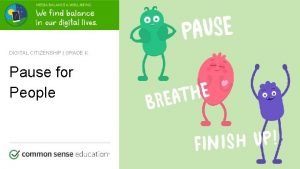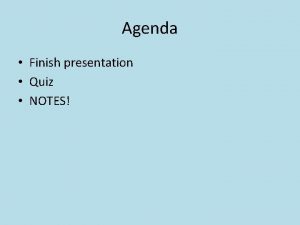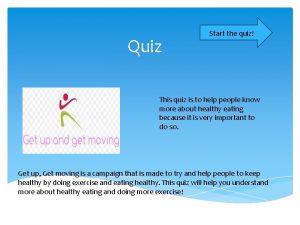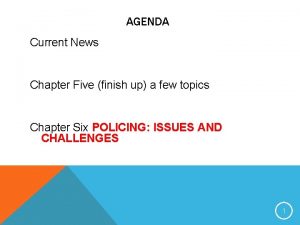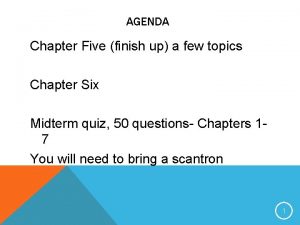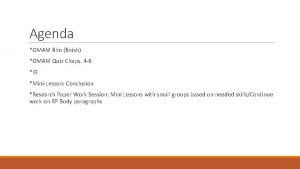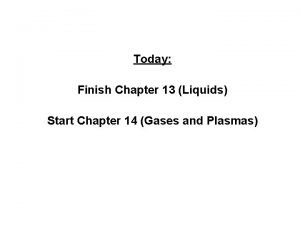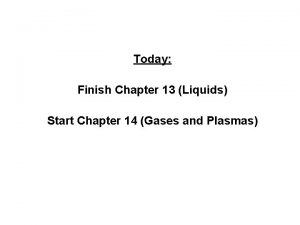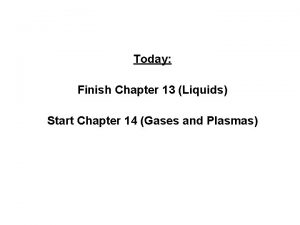AGENDA Quiz Finish up with Chapter Five Start








































































- Slides: 72

AGENDA ü Quiz ü Finish up with Chapter Five Start at slide #34 ü Start thinking about interview 1

Chapter 5 How and Why Drugs Work Instructor Ed Ramirez 2

Introduction A common belief is that drugs can solve most of life’s serious physical, emotional, and medical problems. We’ve covered this so far in the semester, relaxing, escaping, etc. Although medications are essential to treatment for many diseases, excessive reliance on drugs causes unrealistic expectation that may lead to dangerous– even fatal consequences. 3

Celebrities Just because they're legal doesn't mean that prescribed drugs are any less dangerous than illicit drugs. They are potentially deadly when taken in large doses or when combined with alcohol or other drugs. Sometimes it takes high-profile cases to remind us of the dangers. Methaqualone, AKA Quaaludes (sedative) Secobarbital, AKA Seconal (sleeping pill) Pentobarbital and chloral hydrate (sleeping pills) As many as 14 different drugs, including codeine (painkiller) and methaqualone, AKA Quaaludes (sedative) Propofol 4

Some of the drugs used • Elvis, On August 16, 1977, he suffered a heart attack in his Graceland estate, and died as a result. His death came in the wake of many years of prescription drug abuse. • Jimi Hendrix-the cause of death as: "Inhalation of vomit due to barbiturate intoxication ( he took nine sleeping pills) • Heath Ledger-combined effects of Oxycodone, Hydrocodone, Diazepam, Temazepam, Alprazolam, and Doxylamine. 5

What Killed Michael Jackson? Propofol is a potentially deadly drug in the wrong hands, and there is no room for error. "It's only designed for people trained to do advanced cardiac life support, " Dombrowski says. "It induces a deep level of sleep and sedation, and it can cause your blood pressure to go down and your breathing to stop. You can die https: //www. google. com/search? q=propofol Now Used In Missouri Executions 6

Chapter Five In this chapter, we consider the factors that account for the variability of drug responses What determines how the body responds to drugs and why some drugs work while others do not 7

Intended and Unintended Effects of Drugs When physicians prescribe drugs, their objective is usually to cure or relieve symptoms of a disease. However, drugs cause unintended effects that neither the physician nor the patient expected: THESE ARE CALLED SIDE EFFECTS 8

Side effects- Unintended drug responses 9

Side effects 10

Common Side Effects of Drugs • Nausea or vomiting • Changes in mental alertness • Dependence • Withdrawal • Allergic reactions • Changes in cardiovascular activity 11

Opiate withdrawal Unpleasant effects that occur when use of a drug is stopped Withdrawal “Side Effects” 12

Withdrawal 13

Common Side Effects of Drug Figure 5 -1: Common side effects with drugs of abuse. Almost every organ or system in the body can be negatively affected by the substances of abuse. 14

Dose-Response • Many factors can affect the way an individual responds to a drug, including the following: • Dose • Tolerance • Potency 15

Dose-Response (continued) Additional factors Pharmacokinetic properties: Rate of absorption Manner distributed throughout the body Rate metabolized and eliminated Form of the drug Manner in which the drug is administered Defined below -the branch of pharmacology concerned with the movement of drugs within the body 16

Dose-Response Curve Figure 5 -2: Dose-response curve for relieving a headache with aspirin in three users. User A is the most sensitive and has 100% headache relief at a dose of 60 mg. User B is the next most sensitive and experiences 50% headache relief with a 600 -mg dose. The least 17 sensitive is user C: with a 600 -mg dose, user C has no relief from a headache.

Margin of Safety • The range in dose between the amount of drug necessary to cause a therapeutic effect and a toxic effect. 18

Potency vs. Toxicity • Potency: The amount of drug necessary to cause an effect • Toxicity: The capacity of a drug to do damage or cause adverse effects in the body 19

Drug Interaction • A drug’s effect can be dramatically altered when other drugs are also present in the body • This effect is known as DRUG INTERACTION 20

Drug Interaction 21

Grapefruit and certain medications 22

Drug Interaction Cont’d Additive effects ◦ Effects created when drugs are similar and actions are added together Antagonistic (inhibitory) effects ◦ One drug cancels or blocks effects of another Potentiative (synergistic) synergistic effects ◦ Effect of a drug is enhanced by another drug or substance 23

24

Public must be educated about the interactions most likely to occur with drugs that are prescribed, selfadministered legitimately. OTC and Herbal drugs ae as likely to cause interactions problems. Example- Decongestant contains mild CNS stimulants. If taken with Illegal drugs such as cocaine or amphetamines, can cause fatally affect in the heart and brain. 25 Page 155

Figure 05. B 01 A © Monkey Business/Fotolia. com 26

Pharmacokinetic Factors How does the drug enter the body? How does the drug move from the site of administration into body’s system How does the drug move to various areas (distribution) How and where does the drug produce its effects How is the drug inactivated, metabolized excreted from the body 27

Pharmacokinetics The study of factors that influence the distribution and concentration of drugs in the body Pathways Conjugation- 2 compounds resulting in the formation of another Adducts- draw towards 28

29

30

31

Adam Goldstein Better known as DJ AM Overdosed, August, 2009 CNS Depressants Six pills where found in his stomach. An Oxy. Contin capsule was lodged in his throat. 32

Onset vary Figure 05. 03: Relationship between the method of drug administration and drug effects. 33

Half way Forms and Methods of Taking Drugs • oral ingestion • inhalation • injection • topical application Topical Application -made to be put on the skin topical lotions/creams a topical drug/treatment Half way Drugs can be introduced into the body using various methods, such as pills, capsules, oral liquids, topicals, or injections. 34 © Oscar Knott/Fog. Stock/Alamy Images

Oral ingestion One of the most common and convenient ways of taking a drug is orally It is difficult to control the amount of drug that reaches the site of action (Three Reasons) 35

Oral ingestion cont’d 1. The drug must enter the bloodstream passing through the wall of the stomach or intestines without being destroyed or changed into an inactive form 2. Materials in the stomach or intestines such as food may interfere with the passage 3. The liver might metabolized orally ingested drugs to rapidly, before they are able to exert an effect. 36

INHALATION Some drugs are administered by inhalation into the lungs through the mouth or nose 37

Injection 1. Intravenous (IV) 2. Intramuscular (IM) 3. Subcutaneous (SC) Drug injection beneath the skin 38

Topical application • Drugs that readily pass though surface tissues such as the skin 39

Factors affecting Distribution • Most drugs are distributed throughout the body in the blood. • It takes approximately 1 minute for a drug to circulate throughout the body after it enters the bloodstream. • Drugs have different patterns of distribution depending on their chemical properties. We have approximately 5 to 6 liters of blood 40

Factors affecting distribution • Their ability to pass across membranes and through tissues • Their molecular size (large versus small molecules) • Their solubility properties • Their tendency to attach to proteins and tissues throughout the body 41

Factors affecting distribution Cont’d Blood is carried to the nerve cells of the brain in a vast network of thin-walled capillaries. Drugs are soluble in fatty oily solutions are most likely to pass across these capillary membranes known as “the blood-brain barrier” THE BBB is defined as selective filtering between the cerebral blood vessels and the brain 42

The BBB 43

Required Doses for Effects • Threshold dose—the minimum amount of a drug necessary to have an effect • Plateau effect—the maximum effect a drug can have regardless of the dose Example, aspirin, can effectively relieve your mild to moderate pain, but aspirin will not effectively treat your severe pains, regardless of the dose taken. 44

Time-Response Factors • The closer a drug is placed to the target area, the faster the onset of action. • Acute drug response: • Immediate or short-term effects after a single drug dose • Chronic drug response: • Long-term effects after a single dose 45

Time-Response Factors Cont’d Important time factor that influences drug response is the interval between multiple administrations. If sufficient time for drug metabolism and elimination does not separate doses, a drug can accumulate within the body • Cumulative effect—the buildup of drug concentration in the body due to multiple doses taken within short intervals 46

Inactivation and elimination of drugs from the body Half-life- Time required for the body to eliminate and/or metabolize half of a drug dose Metabolism- Chemical alteration of drugs by body processes Usually makes it possible for the body to inactivate, detoxify and excrete drugs and other chemicals. Exception: HEROIN becomes more active when it metabolizes. Metabolites- Chemical products of metabolism 47

Biotransformation • Biotransformation—the process of changing the chemical or pharmacological properties of a drug by metabolism. • The liver is the major organ that metabolizes drugs in the body. • The kidney is the next most important organ for drug elimination. 48

Inactivation and elimination of drugs from the body Cont’d • The body may eliminate small portions of drugs through perspiration and exhalation. Approximately 1% of consumed alcohol is eliminated in the breath and thus may be measured with a 49

Figure 05. B 03: Family Matters: Genetics of Metabolic Enzymes and Alcoholism 50

Inactivation and elimination of drugs from the body Cont’d 51

Physiological Variables That Modify Drug Effects • AGE Changes in body size and makeup occur throughout the aging process • Gender Variations in drug responses due to gender usually relate to differences in body size, composition or hormones • Pregnancy During pregnancy, unique factors must be considered when administering drugs. 52

Physiological Variables That Modify Drug Effects Cont’d • The increase demand can make the woman more susceptible to the toxicity of some drugs • As the fetus develops, it can be very vulnerable to drugs with Teratogenic. Something that causes physical defects in a fetus 53

Teratogenic Remember from chapter 3? ? 54

Adaptive Processes 55 Figure 05. 04: The relationship and consequences of adaptive processes to drug abuse. The processes discussed in the text are highlighted in the figure.

Adaptive Processes • Your body systems are constantly changing • Drugs sometimes interfere with the activity of the body’s systems and compromise their normal workings • Stimulants can dangerously increase the heart rate, blood pressure and can cause heart attacks • Depressants can diminish the brain activity, resulting in unconsciousness and loss of breathing reflexes 56

Figure 05. T 02: Tolerance, Dependence, and Withdrawal Properties of Common Drugs of Abuse 57

THE POPPY SEEDS Figure 05. HN 01 A: Here and Now: Drug Test Results Can be Flawed Data from Fiore, K. “APA: Drug Test Results Often Flawed. ” Med. Page Today. 23 May 2010. Available http: //www. medpagetoday. com/Meeting. Coverage? APA/20253. Accessed March 2, 2011. 58

Figure 05. HN 01 B: Here and Now: Drug Test Results Can be Flawed 59

Tolerance to drugs • Reverse tolerance (sensitization): Enhanced response to a given drug dose; opposite of tolerance • Cross-tolerance: Development of tolerance to one drug causes tolerance to related drugs 60

Drug Dependence Drug dependence can be associates with either physiological or psychological adaptations. Physical dependence reflects changes in the way organs and systems in the body respond to a drug, whereas psychological dependence is caused by changes in attitudes and expectations. 61

Drug Dependence Physical Dependence (e. g. , withdrawal and rebound) Psychological Dependence (e. g. , craving) 62

Physical Dependence In general, the drugs that cause physical dependence also cause a drug withdrawal phenomenon called, “rebound effect” “This is a form of withdrawal; paradoxical effects that occur when a drug has been eliminated from the body” Physical dependence , drug withdrawal- two opposite things and that seems impossible but is actually true or possible 63

Physical Dependence Cont’d Cross Dependence- dependence on a drug can be relieved by other similar drugs Examples- Benzodiazepines and other CNS depressants can be used to treat the abstinence syndrome experienced by the chronic alcoholic Methadone, long acting narcotic, to treat heroin withdrawal 64

Psychological Factors Affecting Drug Effect Individual’s mental set The collection of psychological and environmental factors that influence an individual’s response to a drug Placebo effects Effects caused by suggestion and psychological factors independent of a pharmacological activity of a drug Placebo- From the Latin word meaning, “I shall please. ” 65

Addiction and Abuse • The use of the term addiction is sometimes confusing. It is often used interchangeably with dependence, either physiological or psychological in nature; other times, it is used synonymously with the term drug abuse. A more accurate definition is the compulsive drug use despite negative consequences. 66

Addiction and Abuse (continued) • Factors affecting variability in dependence/addiction: • Hereditary factors (genetic variants); responsible for 40– 60% vulnerability • Drug craving 67

Addiction and Abuse (continued) Other factors contributing to drug use patterns: Positive versus negative effects of drug Peer pressure Home, school, and work environment Mental state 68

Figure 05. B 04: Family Matters: Family Addictions and Genetics 69

Addiction and Abuse (continued) • Other factors contributing to drug use patterns • Positive versus negative effects of drug (dysphoric is the opposite of euphoric) • Peer pressure • Home, school, work environment • Mental state 70

Dysphoric • Characterized by unpleasant mental effects Dysphoric is the opposite of euphoric Figure 5. 4 again DYSPHORIA- a state of dissatisfaction, anxiety, restlessness, or fidgeting. 71

Questions 72
 M a m j j a s o
M a m j j a s o Thames river map
Thames river map Agenda sistemica y agenda institucional
Agenda sistemica y agenda institucional Ad slogan quiz
Ad slogan quiz Site:slidetodoc.com
Site:slidetodoc.com Triage start
Triage start Besra meaning in education
Besra meaning in education The reformation quiz
The reformation quiz The great gatsby ch 8 summary
The great gatsby ch 8 summary And all its aching joys are now no more
And all its aching joys are now no more Five of five
Five of five 5 senses and 5 elements
5 senses and 5 elements Macbeth act five scene five
Macbeth act five scene five 5 themes of geography region pictures
5 themes of geography region pictures Every quiz has been easy. therefore the quiz will be easy
Every quiz has been easy. therefore the quiz will be easy Every quiz has been easy. therefore the quiz will be easy
Every quiz has been easy. therefore the quiz will be easy Chapter 9 chemical names and formulas
Chapter 9 chemical names and formulas Chapter 52 pride and prejudice
Chapter 52 pride and prejudice Main.php?chapter=
Main.php?chapter= How to write a formal email to a company
How to write a formal email to a company If you do your homework last night
If you do your homework last night Ward accreditation for quality
Ward accreditation for quality Finished sketch
Finished sketch Physical finishes
Physical finishes What is fabric finish
What is fabric finish Spin finish oil formulation
Spin finish oil formulation Must or should
Must or should Past simple to paint
Past simple to paint Finish verb 3
Finish verb 3 Jeopardy final question music
Jeopardy final question music Interior finishing materials
Interior finishing materials Finish the sentence icebreaker
Finish the sentence icebreaker Ending of letter formal
Ending of letter formal Complete the sentences using reported speech.
Complete the sentences using reported speech. Rpd finish line
Rpd finish line Surface finish symbols
Surface finish symbols Conditionals finish the sentences
Conditionals finish the sentences Finish conditional sentences
Finish conditional sentences Internal finish line rpd
Internal finish line rpd Enjoy stop finish
Enjoy stop finish Weld mapping symbols
Weld mapping symbols Finish the word dirty mind
Finish the word dirty mind Who you meet last weekend
Who you meet last weekend Passe compose
Passe compose The trust giant's point of view analysis
The trust giant's point of view analysis I have already eaten my breakfast
I have already eaten my breakfast I will finish
I will finish Agape love
Agape love Easy care finish
Easy care finish Completing the square example
Completing the square example Dare verb pattern
Dare verb pattern In the race of excellence there is no finish line
In the race of excellence there is no finish line گرامر object
گرامر object Far singular
Far singular Formal and informal spanish
Formal and informal spanish Finish
Finish Ramit can finish his work in 25 days
Ramit can finish his work in 25 days Finish the following sentence
Finish the following sentence Surface finish symbols
Surface finish symbols Should finish
Should finish Finishgrant.link
Finishgrant.link El verbo hacer en inglés
El verbo hacer en inglés Pause breathe finish up
Pause breathe finish up Present perfect tense sentences
Present perfect tense sentences How long is lent
How long is lent Finish commercial
Finish commercial Teknik melewati garis finish
Teknik melewati garis finish Finish these sentences
Finish these sentences Before you finish eating breakfast this morning meaning
Before you finish eating breakfast this morning meaning Find-fix-finish-exploit-analyze targeting model
Find-fix-finish-exploit-analyze targeting model Chapter 5 summary gatsby
Chapter 5 summary gatsby Five generic competitive strategies examples
Five generic competitive strategies examples Name the five lesions associated with hiv/aids chapter 17
Name the five lesions associated with hiv/aids chapter 17


















